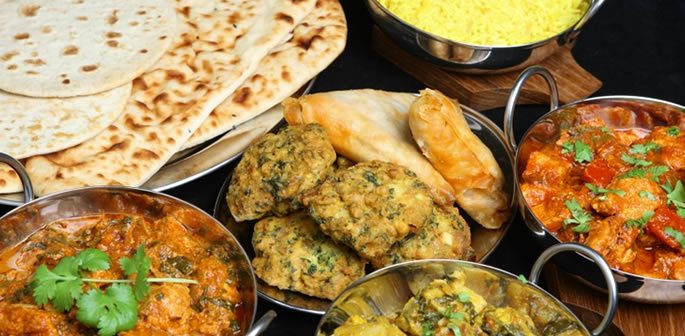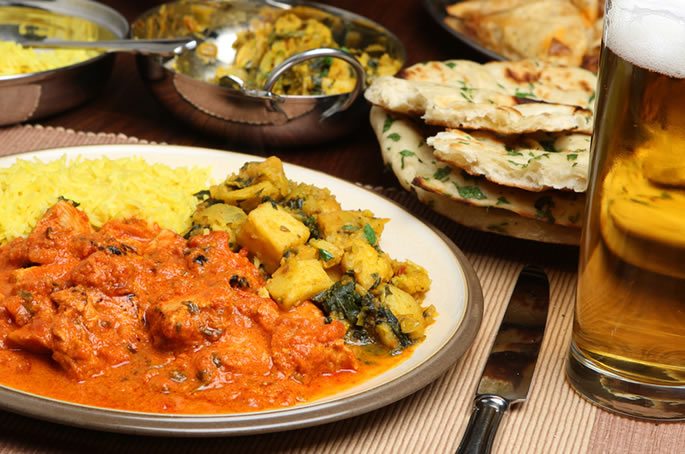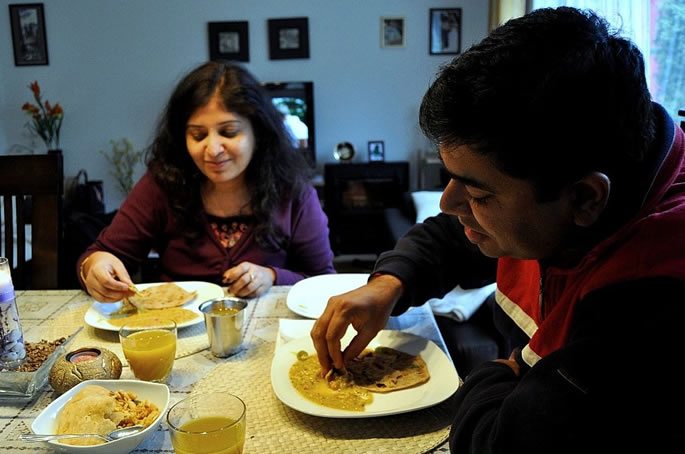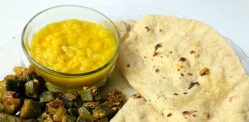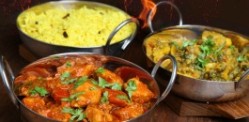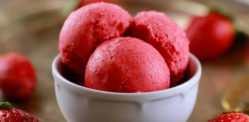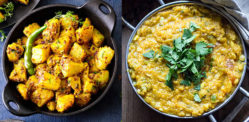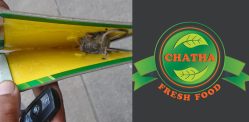we use a lot of oil in our dishes
One of the richest diets high in calories is Indian food.
If you can pinch more than an inch, it’s probably time for you to cut down on the calories you eat in Desi food, especially if you want to lose some pounds to be healthier.
It may seem so innocent just to have that bite-size pakora but we really don’t know exactly what fat or calories it contains. Especially when bought from shops or restaurants.
This is true, most of us don’t actually know what we’re eating when we have an Indian meal at home or at an Indian restaurant.
What Indian food we eat to fill our appetites usually is based on taste and we often don’t know how many calories are in it.
Indian, Pakistani and Bangladeshi dishes, in particular, use large amounts of oil or fat. Traditional Asians tend to use ‘ghee’ or butter which increases hugely both the calories as well as the fat in a dish.
Therefore, if you’re seeking to control the calories when choosing a dish, make sure you minimise the ghee or oil content and have more of the other ingredients.
If cooking Indian food, use alternatives such as olive oil or rapeseed oil. When ordering in an Indian restaurant, request less fat to be used in your dish.
Seasonal eating plays a key role in our diets.
During the winter, we tend to eat heavier foods such as desserts and spoil ourselves with scrumptious hot meals usually full of comforting ingredients. Thus, making it harder to shift the pounds, especially without any or limited form of exercise.
Eating Out
Eating out can always be a dilemma between choosing a tasty dish and one that is low in calories. Therefore, choosing your courses wisely can help you manage the calorie count.
When considering what Indian food to eat for your starter, it is perhaps best to choose something light, such as a popadom as this contains only 65 calories.
Unlike samosas or onion bhaji’s (pakoras) which contain a higher calorie content in each portion.
Dips are used to enhance the taste of a starter but don’t be fooled, these also contain calories.
Cucumber raita or tomato sambal contains approximately 20 calories each.
This is significantly less than mango chutney or lime pickle; a little as 1tbsp can contain up to 70 calories. Yes, you read correctly, 70 calories!
So for a starter choose a popadom with cucumber raita or tomato sambal to accompany it – a course which has fewer calories than most of the other options.
Meat is popular in Desi dishes, so ordering leaner meat like chicken and turkey is better for you than red meat. Go for grilled starters, as they tend to be cooked in a healthier way.
The flavours, spices and the masala (sauce) in a curry are what make it so tasteful.
However, it is often this rich masala that amplifies the calorie content within the curry.
If it’s a low calorific curry you want, it would be beneficial to choose chicken, vegetable or a prawn curry.
The fattiest curries are those which are cooked in a creamy masala. This is because many are cooked with cream and others are cooked in rich butter (makhan).
For example, korma dishes are known to be cooked with cream, ground almonds and saffron. So, to avoid extra calories, stick to drier masala dishes such as Bhuna, Tikka or Tandoori.
For vegetarian options, ‘Daal’ is the lightest of dishes, usually made with lentils and similar pulses.
In general, vegetarian dishes will be healthier than meat dishes.
Dishes with saag (spinach) are high in iron, and many love the favourite of ‘Aloo Gobi’ which is a combination of potatoes and cauliflower cooked in a drier spicy curry.
Pilau rice has a higher calorie content than boiled rice, this is due to the added oil as well as many other ingredients used within it.
Naan bread contains roughly about 300 calories due to the amount of fat and carbohydrates used, whereas, chappatis or tandoori roti will be less.
So, when eating out or ordering takeaways choosing healthier options on menus should be an aim if you want to reduce the calories you consume with Indian food.
Quantities of naan or rotis matter too, so, when in an Indian restaurant, order as you eat without ordering too much upfront and ‘having’ to finish them.
A good tip is not to order naan and rice together. Go for one or the other, not both.
No Indian meal is complete without a traditional dessert.
Indian sweet dishes are always tempting and know exactly how to tickle those taste buds but the taste is always at the expense of higher calories.
Avoiding sweet dishes such as Halwa will help your calorie reduction, especially, gajar ka halwa, which has about 450 grammes of sugar in it and a whopping 570 calories in one portion.
Mysore pak is another Indian sweet dish that has about 357 calories due to the addition of ghee and sugar.
Therefore, when wanting to keep the calories low, choosing barfi or gulab jaman will be a better option, which has about 100 calories in each portion.
Be very careful what Indian food you eat and the quantity despite how appealing it looks, especially when eating out in a restaurant because many calorific ingredients are often used to improve the taste.
Carbohydrates and Indian Food
Try to make more informed choices when it comes to rice and flatbreads in terms of carbohydrates.
Low-carb diets are popular and have proved to be effective. Diets such as keto are also being applied to Indian food.
Diets such as keto promote a higher intake of fats and protein versus carbohydrates.
Rice and flatbreads such as naan and rotis are the higher carbohydrate culprits. However, other foods used in Indian cooking do contain carbs as well.
It is the sugar element in carbohydrates that is viewed as unhealthy.
High carbohydrate foods may include vegetables that are grown under the ground such as root vegetables such as yams, carrots, potatoes, parsnips and beetroot.
Vegetables mostly grown above ground are deemed to be better for you according to keto diet experts. These include courgettes (zucchini), mushrooms, spinach and tomatoes.
Therefore, when looking at making your Indian food choices more healthy, try to choose dishes that contain fewer carbohydrates. Especially, when making or ordering vegetable curries.
Indian Food Calories Chart
Below is an Indian food calorie chart which gives an insight into what is high or low in calories and fat. These are typical values for one average serving of the dish.
|
STARTER DISH |
CALORIES |
FAT |
|
Cucumber Raita , 1tbsp |
20 |
0.1g |
|
Tomato Sambal, 1tbsp |
20 |
0.1g |
|
Mango Chutney, 1tbsp |
60 |
0.1g |
|
Poppadom, each |
65 |
0.5g |
|
Lime Pickle, 1tbsp |
70 |
0.6g |
|
Onion Bhaji, each |
190 |
3.4g |
|
Vegetable Samosa, each |
260 |
16.0g |
|
Meat Samosa, each |
320 |
17.6g |
|
MAIN DISH/FOOD |
CALORIES |
FAT |
|
Tandoori chicken |
264 |
13.7g |
|
Aloo Gobi |
206 |
7.2g |
|
Vegetable Curry |
280 |
18.6g |
|
Chicken Madras |
500 |
32.6g |
|
Saag Aloo |
434 |
24.4g |
|
Vegetable Biryani |
336 |
8.9 |
|
Chicken Tikka Masala |
557 |
52.2g |
|
Chicken Curry |
583 |
39.2g |
|
Lamb Rogan Josh |
589 |
46.0g |
|
Lamb Kheema |
562 |
30.5g |
|
Chicken Korma Curry |
870 |
71.3g |
|
Naan Bread |
317 |
12.3g |
|
Pilau Rice |
449 |
14.4g |
|
Boiled Rice |
362 |
5.0g |
|
SWEET DISH |
CALORIES |
FAT |
|
Barfi |
103 |
2.5g |
|
Halwa |
570 |
21.2g |
|
Gulab Jamun |
108 |
3.0g |
|
Jalebi |
459 |
2.6g |
| Ras Mallai |
250 |
5.0g |
Imagine if you have two samosas, a chicken tikka masala and two naans, and a gulab jamun for a sweet – you easily have a meal that contains over 1800 calories!
When the average calorie for a day are about 2500 for men and 2000 for women, this one meal alone does not leave a lot of calories for the rest of your meals.
Cooking at Home
Making Indian food at home is always a better option than eating out a lot because you have more control over what goes into your dishes.
When making Desi food at home try and observe the calories that you are adding to your dishes.
Review your buying habits when shopping for ingredients. Buy healthier oils and fats, and avoid sugary and creamy items which will increase the calories in your Indian food.
Here are some quick tips:
- Choose better fats for your curries – olive oil, rapeseed oil etc.
- Try and cook more food with fresher ingredients – more vegetables, daals and leaner meat
- Use good spices – they speed up and aid your metabolism, especially turmeric and chillies
- Reduce the amount of salt and sugar – we tend to use too much than the daily limits
- Avoid adding creams or using off-the-shelf sauces. Make your own!
Being a big ‘foody’ does have its downfalls but if you plan out your meals and stay within a reasonable calorie content you should be able to shift enough pounds in time.
All you need is a little hard work to fight off temptation and the determination to fit into that perfect sari or perfect suit for that special date or occasion.



















































